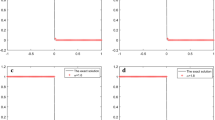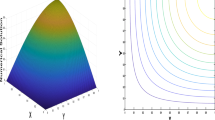Abstract
Though the finite element method has been widely used in solving fractional differential equations, the effects of the Gaussian quadrature rule on the numerical results have rarely been considered. Since the fractional derivatives of the basis functions are not polynomials with integer power and always have weak singularities on some elements, the Gaussian quadrature rule (Gauss-Legendre quadrature rule) may not be suitable in assembling the fractional stiffness matrix. By splitting the integrand of the inner products into a weak singularity part and a smooth part and utilizing the Gauss-Jacobi quadrature rule for the weak singularity part, we present a modified algorithm to assemble the fractional stiffness matrix. The numerical results, conducted on 1D and 2D domains, show that our method can significantly improve the accuracy of the stiffness matrix as well as the accuracy of the numerical solution with much fewer Gaussian points.












Similar content being viewed by others
References
Kulish, V.V., Lage, J.L.: Application of fractional calculus to fluid mechanics. ASME J. Fluids Eng. 124(3), 803–806 (2002). https://doi.org/10.1115/1.1478062
Laskin, N.: Fractional quantum mechanics. Phys. Rev. E 62, 3135–3145 (2000). https://doi.org/10.1103/PhysRevE.62.3135
Bagley, R.L., Torvik, P.J.: A theoretical basis for the application of fractional calculus to viscoelasticity. J. Rheol. 27(3), 201–210 (1983)
Meral, F.C., Royston, T.J., Magin, R.: Fractional calculus in viscoelasticity: an experimental study. Commun. Nonlinear Sci. Numer. Simul. 15(4), 939–945 (2010). https://doi.org/10.1016/j.cnsns.2009.05.004
Magin, R.L., Abdullah, O., Baleanu, D., Zhou, X.J.: Anomalous diffusion expressed through fractional order differential operators in the Bloch-Torrey equation. J. Magn. Reson. 190(2), 255–270 (2008). https://doi.org/10.1016/j.jmr.2007.11.007
Yu, Q., Reutens, D., Vegh, V.: Can anomalous diffusion models in magnetic resonance imaging be used to characterise white matter tissue microstructure?. Neuroimage 175, 122–137 (2018). https://doi.org/10.1016/j.neuroimage.2018.03.052
Samko, S.G., Kilbas, A.A., Marichev, O.I., et al.: Fractional Integrals and Derivatives. Gordon and Breach Science Publishers, Yverdon Yverdon-les-Bains, Switzerland (1993)
Benson, D.A., Wheatcraft, S.W., Meerschaert, M.M.: Application of a fractional advection-dispersion equation. Water Resour. Res. 36(6), 1403–1412 (2000)
Kilbas, A., Srivastava, H.M., Trujillo, J.: Theory and applications of fractional differential equations. Elsevier Science (2006)
Bishehniasar, M., Salahshour, S., Ahmadian, A., Ismail, F., Baleanu, D.: An accurate approximate-analytical technique for solving time-fractional partial differential equations. Complexity, 8718209. https://doi.org/10.1155/2017/8718209 (2017)
Yusuf, A., Qureshi, S., Inc, M., Aliyu, A.I., Baleanu, D., Shaikh, A.A.: Two-strain epidemic model involving fractional derivative with Mittag-Leffler kernel. Chaos: Interdiscip. J. Nonlinear Sci. 28(12), 123121. https://doi.org/10.1063/1.5074084(2018)
Sene, N.: SIR epidemic model with Mittag–Leffler fractional derivative. Chaos Solitons Fractals 137, 109833. https://doi.org/10.1016/j.chaos.2020.109833 (2020)
Meerschaert, M.M., Tadjeran, C.: Finite difference approximations for fractional advection–dispersion flow equations. J. Comput. Appl. Math. 172(1), 65–77 (2004). https://doi.org/10.1016/j.cam.2004.01.033
Zhuang, P., Liu, F., Anh, V., Turner, I.: New solution and analytical techniques of the implicit numerical method for the anomalous subdiffusion equation. SIAM J. Numer Anal. 46(2), 1079–1095 (2008). https://doi.org/10.1137/060673114
Wang, H., Basu, T.S.: A fast finite difference method for two-dimensional space-fractional diffusion equations. SIAM J. Sci. Comput. 34(5), A2444–A2458 (2012). https://doi.org/10.1137/12086491X
Ervin, V.J., Roop, J.P.: Variational formulation for the stationary fractional advection dispersion equation. Numer. Methods Partial Differ. Equ. 22 (3), 558–576 (2006). https://doi.org/10.1002/num.20112
Deng, W.: Finite element method for the space and time fractional Fokker-Planck equation. SIAM. J. Numer. Anal. 47(1), 204–226 (2008). https://doi.org/10.1137/080714130
Li, X., Xu, C.: A space-time spectral method for the time fractional diffusion equation. SIAM J. Numer. Anal. 47(3), 2108–2131 (2009). https://doi.org/10.1137/080718942
Li, C., Zeng, F., Liu, F.: Spectral approximations to the fractional integral and derivative. Fract. Calc. Appl. Anal. 15(3), 383–406 (2012). https://doi.org/10.2478/s13540-012-0028-x
Ervin, V.J., Roop, J.P.: Variational solution of fractional advection dispersion equations on bounded domains in \(\mathbb {R}^{d}\). Numer. Methods Partial Differ. Equ. 23 (2), 256–281 (2007). https://doi.org/10.1002/num.20169
Jin, B., Lazarov, R., Pasciak, J., Zhou, Z.: Error analysis of a finite element method for the space-fractional parabolic equation. SIAM J. Numer. Anal. 52(5), 2272–2294 (2014). https://doi.org/10.1137/13093933x
Bu, W., Tang, Y., Wu, Y., Yang, J.: CRank-Nicolson ADI Galerkin finite element method for two-dimensional fractional FitzHugh-Nagumo monodomain model. Appl. Math. Comput. 257, 355–364 (2015). https://doi.org/10.1016/j.amc.2014.09.034
Feng, L.B., Zhuang, P., Liu, F., Turner, I., Gu, Y.T.: Finite element method for space-time fractional diffusion equation. Numer. Algorithm. 72(3), 749–767 (2016). https://doi.org/10.1007/s11075-015-0065-8
Yang, Z., Yuan, Z., Nie, Y., Wang, J., Zhu, X., Liu, F.: Finite element method for nonlinear Riesz space fractional diffusion equations on irregular domains. J. Comput. Phys. 330, 863–883 (2017). https://doi.org/10.1016/j.jcp.2016.10.053
Fan, W., Liu, F., Jiang, X., Turner, I.: A novel unstructured mesh finite element method for solving the time-space fractional wave equation on a two-dimensional irregular convex domain. Fract. Calc. Appl. Anal. 20(2). https://doi.org/10.1515/fca-2017-0019 (2017)
Yang, Z., Nie, Y., Yuan, Z., Wang, J.: Finite element methods for fractional PDEs in three dimensions. Appl. Math. Lett. 100, 106041. https://doi.org/10.1016/j.aml.2019.106041 (2020)
Acosta, G., Bersetche, F.M., Borthagaray, J.P., short, A: FE Implementation for a 2d homogeneous dirichlet problem of a fractional laplacian. Comput. Math. Appl. 74(4), 784–816 (2017). https://doi.org/10.1016/j.camwa.2017.05.026
Acosta, G., Borthagaray, J.P.: A fractional laplace equation: Regularity of solutions and finite element approximations. SIAM. J. Numer. Anal. 55 (2), 472–495 (2017). https://doi.org/10.1137/15m1033952
Lai, J., Liu, F., Anh, V.V., Liu, Q.: A space-time finite element method for solving linear Riesz space fractional partial differential equations. Numer. Algorithm. https://doi.org/10.1007/s11075-020-01047-9 (2021)
Shen, J., Tang, T., Wang, L. -L.: Spectral Mehtods: algorithms, Analysis and Applications, 1st Edition, no. 41 in Springer Series in Computational Mathematics Springer, Berlin. https://doi.org/10.1007/978-3-540-71041-7 (2011)
Funding
This research was supported by the National Natural Science Foundation of China (11971386), the National Key R&D Program of China (2020YFA0713603), the Natural Science Foundation of Shaanxi Province (2020JM-132), and the Fundamental Research Funds for the Central Universities (310201911cx025).
Author information
Authors and Affiliations
Corresponding author
Additional information
Publisher’s note
Springer Nature remains neutral with regard to jurisdictional claims in published maps and institutional affiliations.
Rights and permissions
About this article
Cite this article
Yang, Z., Wang, J., Yuan, Z. et al. Using Gauss-Jacobi quadrature rule to improve the accuracy of FEM for spatial fractional problems. Numer Algor 89, 1389–1411 (2022). https://doi.org/10.1007/s11075-021-01158-x
Received:
Accepted:
Published:
Issue Date:
DOI: https://doi.org/10.1007/s11075-021-01158-x
Keywords
- Finite element method
- Riemann-Liouville fractional derivatives
- Gaussian quadrature rule
- Gauss-Jacobi quadrature rule
- Fractional stiffness matrix




